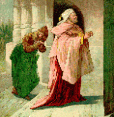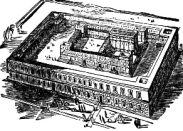New Testament Survey
Religions
Before actually investigating the New Testament, one final set of conditions must be explored. This is the area of religion. While Greek and Roman influences battled with each other for control of land and language, in religious circles the results were different. Over the years the great Greek gods and the equally great Roman gods all merged into a set of matched deities. The great gods and goddesses were identified one with the other, although by the time of Christ, their influence was on the wain. However, Acts 14 reflects their continued existence.
Emperor worship was another religion of the region. While the deification of the emperors usually occurred after their death, some, like Nero, would declare themselves gods while still ruling. Nero was the emperor at the time of Paul’s and Peter’s time in Rome. Christians could not / would not worship the emperor, creating conflict with the ruling powers.
Mystery religions also existed. These used ecstatic experiences, secret rites and rituals, ceremonial washing, blood sprinkling, intoxication, emotional frenzy, pageantry, and temple prostitutes as a means of coming into union with the gods. Gnosticism, epicureanism, stoicism, cynics, and sceptics all are religions or philosophies which existed or arise, at least in their rudiments, during the early days of the church. For example, Colossians and 1 John were probably dealing with early forms of gnosticism.

Lastly, it is necessary to understand the Jewish religious structure and the important political parties of Israel in order to understand the tensions of the New Testament. The institutions, religious cults, and political groups which make up Israel at the time of Christ and the early church may be briefly outlined as follows:
Pharisees: Their name comes from a Hebrew word meaning “to separate.” The Pharisees probably grew out of an early sect known as the Hassidim or pious ones. In today’s Jewish community, the Hasidic Jew, those with the black coats, black wide brimmed hats, and flowing beards, are the equivalent of the Hassidim. The Pharisees promoted tradition to the level of Scripture. They probably only numbered about 6,000 at the time of Christ, but they represented the people and, thus, wielded a strong influence.
Scribes: These are the “lawyers” of the community. Their job was to teach and interpret the law. Part of their task was to formulate the oral law. Later, into the second century, their formulations were reduced to writing in what is known as the Talmud. Because of this knowledge of the law, the scribes were responsible to determine who broke the law. All scribes were Pharisees, but not all Pharisees were scribes.
Sadducees: Their name may have been derived from the name “Zadok” whom David made high priest. On the other hand, their name may also come from the Hebrew word zedekah, which means righteousness. Less numerous than the Pharisees, the Sadducees were the rich and political members of the Nation, the “rich and famous.” It is possible the Sadducees grew out of the Hasmonean family since their descriptions are much the same. The Sadducees felt that only the books of Moses (Genesis to Deuteronomy) carried any authority. They did not believe in angels, demons, resurrection, or a coming Messiah. This put them at odds with the Pharisees.

Essenes: Not mentioned in Scriptures, some feel that John the Baptist may have had contact with this sect. Pious and studious, they lived near the Dead Sea in an isolated community. Their library collection was discovered in the late 1940s and is popularly known as the Dead Sea Scrolls. These scrolls help to confirm the accuracy of the Old Testament critical manuscripts. However, there are no New Testament books among the collection.

A critical manuscript is a composite effort by scholars and students of the Bible to create a document which is as close to the original as possible. The Jewish community known as the Masoretes worked from about A.D. 400 to 1,000 creating a critical Hebrew manuscript. This is still the primary manuscript for studying and translating the Old Testament and is now known as the Biblia Hebraica. The current critical manuscript of the New Testament is printed by the United Bible Societies (among others) and is in its 4th edition. It is based upon the work over the past century known as the Nestle-Aland manuscript which is in its 28th edition. Part of the controversy over modern translations has to do with one’s opinion of the accuracy and conclusions which have gone into the creation of these critical manuscripts.
Herodians: This is the political party and, as may be deduced by the name, this group supported Herod the Great and his successors. It is probable that many of the Jewish tax collectors were Herodians. Could this have included Matthew?
Zealots: These are the revolutionists of the Jewish culture. They wanted to take Rome on head-to-head and throw the foreigners out of Israel. They were responsible for a number of revolts throughout the first century A.D. It was their activities in A.D. 66-72 which brought the Roman army to Jerusalem and resulted in Titus destroying the Temple in A.D. 70. There is speculation that Judas Iscariot was a Zealot. Simon the Apostle was probably also a zealot (Matt 10:4 NIV).
Sanhedrin: This was the Supreme Court of Israel. The Great Sanhedrin sat in Jerusalem and ruled the country. Smaller sanhedrins could be found throughout the Nation. The council had seventy-one members. There were 24 “chief priests” representing the priesthood, 24 elders, the elders of the people (Matt 21:23), and 22 scribes, plus the high priest who acted as its president.
Synagogue: This is the local Jewish church. Probably this institution commenced during the Babylonian captivity when the Nation was in exile and the Temple destroyed. Ten pious men can start a synagogue, so they were numerous. The story is told that when the Temple was destroyed by Titus there were 450 synagogues in existence in Jerusalem! The services enjoyed great freedom which allowed both Jesus and Paul to make use of them for purposes of spreading the good news.

The Temple: This is the Second Temple, the one built by Ezra. Herod the Great undertook a renovation project which brought him great favor in Jewish religious circles. Herod’s renovations were commenced in 19 B.C. but were not completed until well after his death. The Temple work was finished in A.D. 64, just six short years before the Roman army reduced the Temple to rubble. The Temple was actually a series of courtyards and buildings. The outer courtyard was known as the Court of the Gentiles. Anyone could enter this area. This most likely is the area of the merchants and moneychangers attacked by Jesus. Next is the court of women. Gentiles faced death if they entered this court. Lastly is the court of Israel. Only Jewish men could enter this court. Inside the court of Israel stood the Holy Place and the Holy of Holies, patterned after the Tabernacle constructed by Moses in the wilderness. Of course, at this time in the Jewish history, there was no Ark of the Covenant nor mercy seat. It should also be noted that the Romans allowed the Jews to have their own Temple police. This is possibly the band which arrested Jesus. The entire complex was surrounded by a series of porches where rabbis, including Jesus, taught their disciples. It is also possible these porches provide an alternative location for the merchants and money-changers.
The Jewish people must be viewed as a composite group, regionally different, similar to the American concepts of an “Easterner,” a “Southerner,” a “Westerner,” or a “Californian”! Those who lived in Jerusalem viewed themselves as the keeper of the religion. Galileans were “country cousins,” Jewish, but a little “different.”

On the other hand, notice as we review the Gospels that eleven of the twelve apostles were from Galilee. Judas Iscariot is the only one from Judah. Notice also that about 2/3rds (23, depending upon how one considers some events and “counts”) of the miracles performed by Christ take place in Galilee while only 6 occur in Jerusalem.

It should be noted that the Jewish population at the time of Christ is estimated at 4 million, about 7% of the total population of the Roman Empire. Only about 700,000 of the total Jewish population called Palestine home. There were more Jews living in Alexandria, Egypt at this time then there were in Jerusalem.
Totally different were the Samaritans. At the time of the exile of the Northern kingdom in 721 B.C., the Assyrians left some remnant of Israelites in the land. At the same time, they brought outsiders into the area to help settle, preserve and work the land. Not surprisingly, the two groups intermarried. The result were the Samaritans, a people racially distinct from the Jews. This group set up their own centers of worship during the exile and changed their methods of worship. But, they still viewed themselves as worshiping the God of the Jews. Needless to say, the Jews did not see it this way, creating friction. This friction is the backdrop of several episodes in Scripture.
This, then, is the political, cultural, and religious background which makes up the “fullness of time” into which God stepped.
